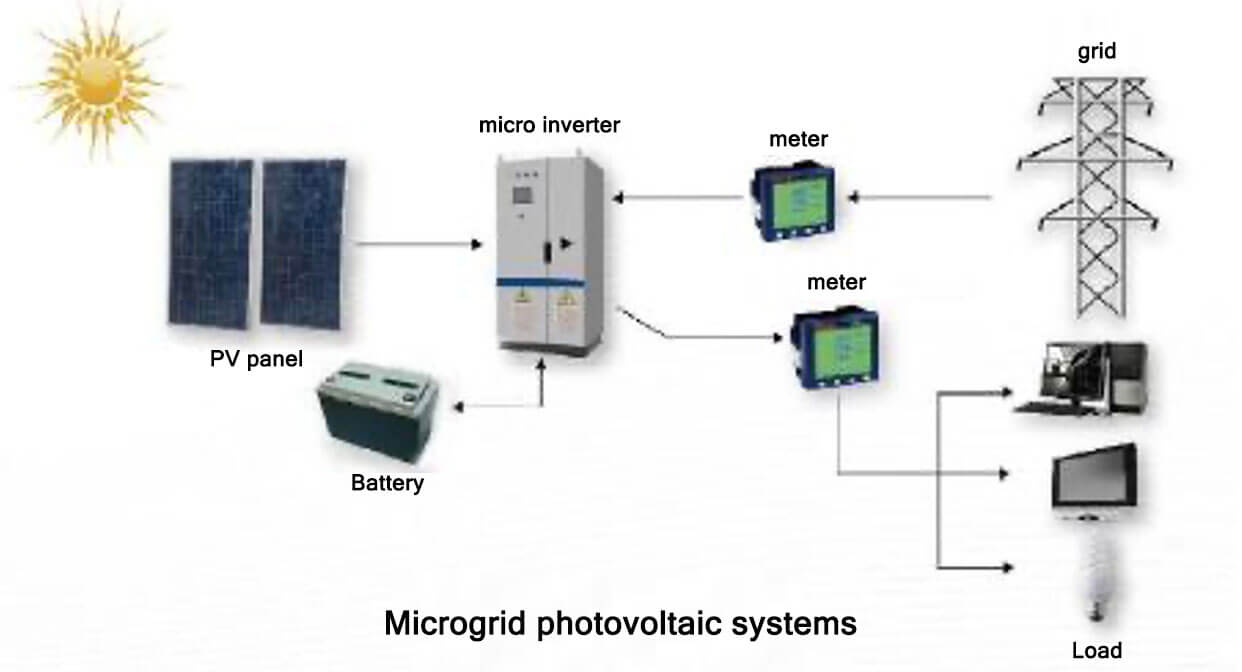With the rapid development of the economy, the energy shortage is becoming more and more serious. Faced with the dual pressure of energy demand and environmental protection, countries around the world have adopted strategies such as increasing energy utilization, improving energy structure, and developing renewable energy. As a representative of new energy power generation, solar photovoltaic power generation has been formally applied in actual production. Photovoltaic power supply is different from traditional power supply. Its output power changes drastically with the change of environmental factors such as light intensity and temperature, and it is uncontrollable. Therefore, if photovoltaic power generation is to replace traditional energy sources to achieve large-scale grid-connected power generation, its impact on the power grid cannot be ignored. Moreover, as the proportion of photovoltaic systems in the grid continues to increase, its impact on the grid must be effectively managed to ensure the safety and reliability of power supply. The application of energy storage system in photovoltaic power generation system can solve the problem of unbalanced power supply in photovoltaic power generation system to meet the requirements of normal operation. Energy storage systems are crucial to the stable operation of photovoltaic power plants. The energy storage system not only ensures the stability and reliability of the system, but also is an effective way to solve dynamic power quality problems such as voltage pulses, inrush currents, voltage dips, and instantaneous power interruptions.

1. Battery energy storage
Battery energy storage is one of the most promising energy storage methods among various energy storage technologies. It has the characteristics of high reliability and high degree of modularization, and is often used in distribution networks in load areas that require high power supply quality. Battery energy storage mainly uses the oxidation-reduction reaction of the positive and negative electrodes of the battery to charge and discharge. The battery energy storage can solve the power demand of the system during the peak load, and the battery energy storage can also be used to assist the reactive power compensation device, which is beneficial to suppress voltage fluctuations and flicker. At present, common batteries include lead-acid batteries, lithium-ion batteries, sodium-sulfur batteries, and flow batteries. Literature analyzed the role of the battery in the photovoltaic power generation system: energy storage, clamping the working voltage of the solar cell, and providing a large instantaneous current. Literature focuses on several common chemical energy storage technologies at present, selects key technical indicators, collects the latest application data of chemical energy storage technologies up to 2011, combines data envelopment (DEA) analysis method, explores the advantages and application effects of various chemical energy storage technologies, and provides suggestions and references for the future research direction of chemical energy storage technologies.
2. Super capacitor energy storage
Super capacitor is a porous medium made of special materials. Compared with ordinary capacitors, it has a higher dielectric constant, greater voltage resistance and greater storage capacity, and maintains the characteristics of traditional capacitors that release energy quickly. It is gradually accepted in the field of energy storage. According to different energy storage principles, super capacitors can be divided into electric double layer capacitors and electrochemical capacitors. As an emerging energy storage element, super capacitor has many advantages compared with other energy storage methods. Compared with batteries, super capacitors have the characteristics of high power density, long charge and discharge cycle life, high charge and discharge efficiency, fast charge and discharge rate, good high and low temperature performance, and long energy storage life. However, super capacitors also have many disadvantages, mainly including low energy density, relatively large fluctuation range of terminal voltage, and voltage equalization of capacitors in series. Judging from the characteristics of batteries and super capacitors, the two are highly complementary in technical performance. Mixing super capacitors with batteries will greatly improve the performance of energy storage devices. Literature found that the parallel connection of super capacitors and batteries can improve the power output capability of the hybrid energy storage device, reduce internal losses, and increase the discharge time; it can reduce the number of charge and discharge cycles of the battery and prolong its service life; it can also reduce the volume of the energy storage device and improve the reliability and economy of the power supply system.
3. flywheel energy storage
Flywheel energy storage technology is a mechanical energy storage method, which can have the advantages of high efficiency, short construction period, long life, high energy storage, etc., and it can be charged quickly, with unlimited charge and discharge times, and has no pollution to the environment. However, the maintenance cost of flywheel energy storage is much more expensive than other energy storage methods. Literature, on the basis of analyzing the structure and characteristics of the photovoltaic flywheel energy storage system, proposed a fuzzy control-based active power smoothing control of the photovoltaic flywheel energy storage system. Using the Matlab/Simulink platform, the flywheel speed, power output status and smoothing coefficient of the photovoltaic flywheel energy storage system were simulated and analyzed, and compared with the two devices of no flywheel energy storage and simple flywheel energy storage. Literature is based on the maximum power tracking of photovoltaic power generation and grid-connected inverter control, and introduces a flywheel energy storage system to achieve stable power output to the grid. In order to make the photovoltaic power generation system output schedulable and stable electric energy to the grid, the current inner loop, the voltage outer loop control mode is used to charge and the current inner loop, the voltage outer loop control mode is discharged, so that the whole system outputs stable and schedulable active power, effectively suppressing the fluctuation of the photovoltaic power generation system output active power to the grid caused by the fluctuation of light and ambient temperature.

4. Superconducting energy storage
The superconducting energy storage system (SMES) uses coils made of superconducting wires to store the magnetic field energy generated by the grid-powered excitation, and then send the stored energy back to the grid when needed. Superconducting energy storage systems usually include superconducting coils placed in a vacuum-insulated cooling container, cryogenic and vacuum mercury systems, and power electronics for control. The current circulates continuously in the closed inductance formed by the superconducting coil and will not disappear. Compared with other energy storage technologies, superconducting energy storage has significant advantages: because it can store energy without loss for a long time, the energy return efficiency is very high; the energy release speed is fast, usually only a few seconds; the use of SMES can make the grid voltage, frequency, active and reactive power easy to adjust. Literature proposes to use a superconducting energy storage unit to stabilize the output voltage and frequency of the wind turbine. The SEMS unit is connected to the busbar of the asynchronous generator. The active power controller of the SEMS uses the speed deviation of the asynchronous generator as the control signal. Literature proposed a strategy of using voltage deviation as the control signal of the SEMS active power controller in view of the frequent short-circuit faults of the tie line and the wind speed disturbance of the wind farm. Various studies have shown that SEMS devices have excellent performance in improving the stability of wind farms.




